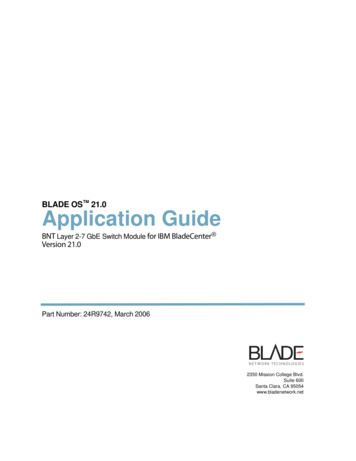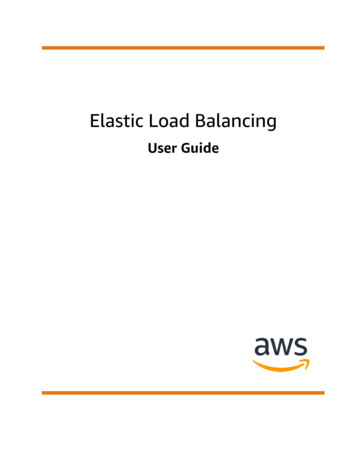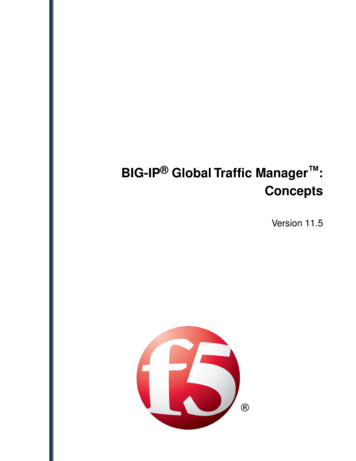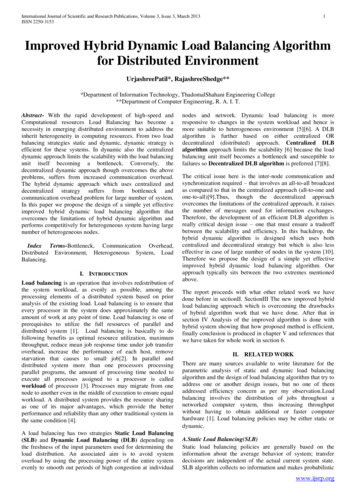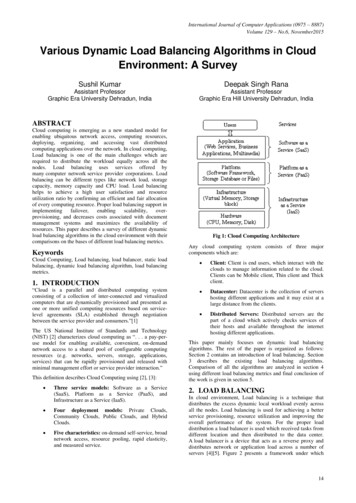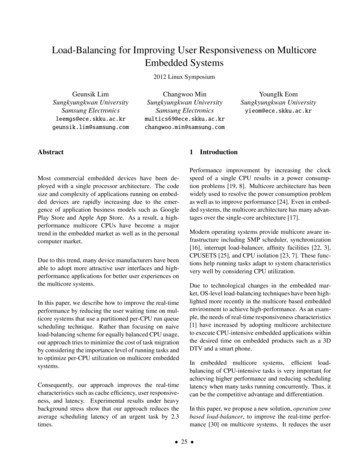
Transcription
Load-Balancing for Improving User Responsiveness on MulticoreEmbedded Systems2012 Linux SymposiumGeunsik LimSungkyungkwan UniversitySamsung ElectronicsChangwoo MinSungkyungkwan UniversitySamsung comAbstract1Most commercial embedded devices have been deployed with a single processor architecture. The codesize and complexity of applications running on embedded devices are rapidly increasing due to the emergence of application business models such as GooglePlay Store and Apple App Store. As a result, a highperformance multicore CPUs have become a majortrend in the embedded market as well as in the personalcomputer market.Due to this trend, many device manufacturers have beenable to adopt more attractive user interfaces and highperformance applications for better user experiences onthe multicore systems.In this paper, we describe how to improve the real-timeperformance by reducing the user waiting time on multicore systems that use a partitioned per-CPU run queuescheduling technique. Rather than focusing on naiveload-balancing scheme for equally balanced CPU usage,our approach tries to minimize the cost of task migrationby considering the importance level of running tasks andto optimize per-CPU utilization on multicore embeddedsystems.Consequently, our approach improves the real-timecharacteristics such as cache efficiency, user responsiveness, and latency. Experimental results under heavybackground stress show that our approach reduces theaverage scheduling latency of an urgent task by 2.3times.YoungIk EomSungkyungkwan nce improvement by increasing the clockspeed of a single CPU results in a power consumption problems [19, 8]. Multicore architecture has beenwidely used to resolve the power consumption problemas well as to improve performance [24]. Even in embedded systems, the multicore architecture has many advantages over the single-core architecture [17].Modern operating systems provide multicore aware infrastructure including SMP scheduler, synchronization[16], interrupt load-balancer, affinity facilities [22, 3],CPUSETS [25], and CPU isolation [23, 7]. These functions help running tasks adapt to system characteristicsvery well by considering CPU utilization.Due to technological changes in the embedded market, OS-level load-balancing techniques have been highlighted more recently in the multicore based embeddedenvironment to achieve high-performance. As an example, the needs of real-time responsiveness characteristics[1] have increased by adopting multicore architectureto execute CPU-intensive embedded applications withinthe desired time on embedded products such as a 3DDTV and a smart phone.In embedded multicore systems, efficient loadbalancing of CPU-intensive tasks is very important forachieving higher performance and reducing schedulinglatency when many tasks running concurrently. Thus, itcan be the competitive advantage and differentiation.In this paper, we propose a new solution, operation zonebased load-balancer, to improve the real-time performance [30] on multicore systems. It reduces the user 25
26 Load-Balancing for Improving User Responsiveness on Multicore Embedded SystemsSTARTENDTasksTasksTasksSchedulertickTask rescheduling(Context switching)DequeuetasksRebalancetickEnqueuetasksCPU reschedulingCaculation of CPU usageMove tasks(Task migration)Imbalance controllerFind busiest queueLoad-balanceamong CPUs ?NOFind busiest groupYESAt every timer tick, the SMP scheduler determineswhether it needs to start load-balancing [20] or not,based on the number of tasks in the per-CPU run-queue.At first, it calculates the average load of each CPU [12].If the load imbalance between CPUs is not fair, the loadbalancer selects the task with the highest CPU load [13],and then lets the migration thread move the task to thetarget CPU whose load is relatively low. Before migrating the task, the load-balancer checks whether thetask can be instantly moved. If so, it acquires twolocks, busiest- lock and this rq- lock, for synchronization before moving the task. After the successful task migration, it releases the previously helddouble-locks [5]. The definitions of the terms in Figure 1 are as follows [10] [18]:Figure 1: Load-balancing operation on Linuxwaiting time by using a partitioned scheduling—or perCPU run-queue scheduling—technique. Our solutionminimizes the cost of task migration [21] by considering the importance level of running tasks and perCPU utilization rather than focusing on naive CPU loadbalancing for balanced CPU usage of tasks.Finally, we introduce a flexible task migration methodaccording to load-balancing operation zone. Ourmethod improves operating system characteristics suchas cache efficiency, effective power consumption, userresponsiveness, and latency by re-balancing the activities that try to move specific tasks to one of the CPUson embedded devices. This approach is effective on themulticore-based embedded devices where user responsiveness is especially important from our experience.2Load-balancing mechanism on LinuxThe current SMP scheduler in Linux kernel periodicallyexecutes the load-balancing operation to equally utilizeeach CPU core whenever load imbalance among CPUcores is detected. Such aggressive load-balancing operations incur unnecessary task migrations even when theCPU cores are not fully utilized, and thus, they incuradditional cache invalidation, scheduling latency, andpower consumption. If the load sharing of CPUs isnot fair, the multicore scheduler [10] makes an effort tosolve the system’s load imbalance by entering the procedure for load-balancing [11]. Figure 1 shows the overalloperational flow when the SMP scheduler [2] performsthe load-balancing. Rebalance tick: update the average load of the runqueue. Load balance: inspect the degree of load imbalance of the scheduling domain [27]. Find busiest group: analyze the load of groupswithin the scheduling domain. Find busiest queue: search for the busiest CPUwithin the found group. Move tasks: migrate tasks from the source runqueue to the target run-queue in other CPU. Dequeue tasks: remove tasks from the externalrun-queue. Enqueue tasks: add tasks into a particular CPU. Resched task: if the priority of moved tasks ishigher than that of current running tasks, preemptthe current task of a particular CPU.At every tick, the scheduler tick() function callsrebalance tick() function to adjust the load ofthe run-queue that is assigned to each CPU. Atthis time, load-balancer uses this cpu index of local CPU, this rq, flag, and idle (SCHED IDLE,NOT IDLE) to make a decision. The rebalancetick() function determines the number of tasks thatexist in the run-queue. It updates the average load of therun-queue by accessing nr running of the run-queuedescriptor and cpu load field for all domains from thedefault domain to the domain of the upper layer. If the
2012 Linux Symposium 27load imbalance is found, the SMP scheduler starts theprocedure to balance the load of the scheduling domainby calling load balance() function.It is determined by idle value in the sched domaindescriptor and other parameters how frequently loadbalancing happens. If idle value is SCHED IDLE,meaning that the run-queue is empty, rebalancetick() function frequently calls load balance()function. On the contrary, if idle value is NOT IDLE,the run-queue is not empty, and rebalance tick()function delays calling load balance() function. Forexample, if the number of running tasks in the run-queueincreases, the SMP scheduler inspects whether the loadbalancing time [4] of the scheduling domain belongingto physical CPU needs to be changed from 10 milliseconds to 100 milliseconds.When load balance() function moves tasks from thebusiest group to the run-queue of other CPU, it calculates whether Linux can reduce the load imbalance ofthe scheduling domain. If load balance() functioncan reduce the load imbalance of the scheduling domain as a result of the calculation, this function gets parameter information like this cpu, this rq, sd, andidle, and acquires spin-lock called this rq- lockfor synchronization. Then, load balance() functionreturns sched group descriptor address of the busiestgroup to the caller after analyzing the load of the groupin the scheduling domain by calling find busiestgroup() function. At this time, load balance()function returns the information of tasks to the caller tomove the tasks into the run-queue of local CPU for theload-balancing of scheduling domain.The kernel moves the selected tasks from the busiestrun-queue to this rq of another CPU. After turning onthe flag, it wakes up migration/* kernel thread. Themigration thread scans the hierarchical scheduling domain from the base domain of the busiest run-queue tothe top in order to find the most idle CPU. If it findsrelatively idle CPU, it moves one of the tasks in the busiest run-queue to the run-queue of relatively idle CPU(calling move tasks() function). If a task migrationis completed, kernel releases two previously held spinlocks, busiest- lock and this rq- lock, and finally it finishes the task migration.dequeue task() function removes a particular task inthe run-queue of other CPU. Then, enqueue task()function adds a particular task into the run-queue of lo-cal CPU. At this time, if the priority of the moved task ishigher than the current task, the moved task will preemptthe current task by calling resched task() function togain the ownership of CPU scheduling.As we described above, the goal of the load-balancing isto equally utilize each CPU [9], and the load-balancingis performed after periodically checking whether theload of CPUs is fair. The load-balancing overhead iscontrolled by adjusting frequency of load-balancing operation, load balance() function, according to thenumber of running tasks in the run-queue of CPU. However, since it always performs load-balancing whenevera load imbalance is found, there is unnecessary loadbalancing which does not help to improve overall system performance.In multicore embedded systems running many user applications at the same time, load imbalance will occurfrequently. In general, more CPU load leads to morefrequent task migration, and thus, incurs higher cost.The cost can be broken down into direct, indirect, andlatency costs as follows:1. Direct cost: the load-balancing cost by checkingthe load imbalance of CPUs for utilization andscalability in the multicore system2. Indirect cost: cache invalidation and power consumption(a) cache invalidation cost by task migrationamong the CPUs(b) power consumption by executing more instructions according to aggressive loadbalancing3. Latency cost: scheduling latency and longer nonpreemptible period(a) scheduling latency of the low priority task because the migration thread moves a number oftasks to another CPU [29](b) longer non-preemptible period by holding thedouble-locking for task migrationWe propose our operation zone based load-balancer inthe next section to solve those problems.
28 Load-Balancing for Improving User Responsiveness on Multicore Embedded SystemsLoad BalancerRun queue90Run queueCPU0 (50%)XDelayed Balancing* Highest task migrationsThreshold100Hot Zone80 CP70 UNew tasksWait queueCPU1 (23%)Idle tasksRun queue60 Us50 ag40 e(%)30Alwaysload-balancing* High spot[/proc/sys/kernel/balance level]0: Cold zone *1: Warm zone(Low spot)2: Warm zone(Mid spot )3: Warm zone(High spot)4: Hot zone[/proc/sys/kernel/bal cpus avg enable]1: Calculation of avg cpus0: Specified local cpu *Warm Zone* Mid spot* Low spot[/proc/sys/kernel/balance idle cal]0: No consider idle CPUs1: Consider idle CPUs *’*’ mark : default value20CPU2 (65%)Run queue10Kernel timerCold ZoneNo load-balancing0* Lowest task migrationsCPU3 (30%)Multi-core CPUFigure 3: Load-balancing operation zoneFigure 2: Flexible task migration for low latency3Operation zone based load-balancerIn this section, we propose a novel load-balancingscheduler called operation zone based load-balancerwhich flexibly migrates tasks for load-balancing basedon load-balancing operation zone mechanism whichis designed to avoid too frequent unnecessary loadbalancing. We can minimize the cost of the loadbalancing operation on multicore systems while maintaining overall CPU utilization balanced.The existing load-balancer described in the previous section regularly checks whether load-balancing isneeded or not. On the contrary, our approach checksonly when the status of tasks can be changed. As illustrated in Figure 2, operation zone based load-balancerchecks whether the task load-balancing is needed in thefollowing three cases: A task is newly created by the scheduler. An idle task wakes up for scheduling. A running task belongs to the busiest schedulinggroup.The key idea of our approach is that it defers loadbalancing when the current utilization of each CPU isnot seriously imbalanced. By avoiding frequent unnecessary task migration, we can minimize heavy doublelock overhead and reduce power consumption of a battery backed embedded device. In addition, it controlsthe worst-case scenario: one CPU load exceeds 100%even though other CPUs are not fully utilized. For example, when a task in idle, newidle, or noactivestate is rescheduled, we can make the case that does notexecute load balance() routine.3.1Load-balancing operation zoneOur operation zone based load-balancer provides loadbalancing operation zone policy that can be configuredto the needs of the system. As illustrated in Figure 3, itprovides three multicore load-balancing policies basedon the CPU utilization. The cold zone policy looselyperforms load-balancing operation; it is adequate whenthe CPU utilization of most tasks is low.On the contrary, the hot zone policy performs loadbalancing operation very actively, and it is proper underhigh CPU utilization. The warm zone policy takes themiddle between cold zone and hot zone.Load-balancing under the warm zone policy is not trivial because CPU utilization in warm zone tends to fluctuate continuously. To cope with such fluctuations,warm zone is again classified into three spots—high,mid, and low—and our approach adjusts scores basedon weighted values to further prevent unnecessary taskmigration caused by the fluctuation. We provide /procinterfaces for a system administrator to configure thepolicy either statically or dynamically. From our experience, we recommend that a system administrator configures the policy statically because of system complexity.
2012 Linux Symposium 293.1.1Cold zone/proc/sys/kernel/bal cpus avg enable 1In a multicore system configured with the cold zone policy, our operation zone based load-balancing schedulerdoes not perform any load-balancing if the CPU utilization is in cold zone, 0 30%. Since there is no task migration in cold zone, a task can keep using the currentlyassigned CPU. Kernel performs the load-balancing onlywhen the CPU utilization exceeds cold zone.This policy is adequate where the CPU utilization of adevice tends to be low except for some special cases. Italso helps to extend battery life in battery backed devices.Warm zone (High spot)Warm zone (Mid spot)CPU0CPU1Utilization 50%CPU0Utilization 50%Utilization 85%CPU1Utilization 85%Task Migration XTask Migration OCPU2Utilization 25%CPU2Utilization 25%CPU3Utilization 55%CPU3Utilization 55%if(CPUs Average Usage 53.75% 50%(Normal)) go load-balancingif (CPUs Average Usage 53.75% 80%(High)) go load-balancing[bal cpu avg enable 1][bal cpu avg enable 0]3.1.2Hot zoneTask migration in the hot zone policy is opposite to thatin the cold zone policy. If the CPU utilization is in hotzone, 80 100%, kernel starts to perform load-balancing.Otherwise, kernel does not execute the procedure ofload-balancing at all.Under the hot zone policy, kernel defers load-balancinguntil the CPU utilization reaches hot zone, and thus, wecan avoid many task migrations. This approach bringsinnovative results in the multicore-based system for thereal-time critical system although the system throughputis lost.3.1.3Warm zoneIn case of the warm zone policy, a system administratorchooses one of the following three spots to minimize thecosts of the load-balancing operation for tasks whoseCPU usage is very active.if(Local CPU1 Usage 85% 50%(Normal)) go load-balancingif (Local CPU1 Usage 85% 80%(High)) go load-balancingFigure 4: Task migration example in warm zone policyThe spot performs the role of controlling the CPU usageof tasks that can be changed according to weight score.In the warm zone policy system, weight-based scoresare applied to tasks according to the period of the CPUusage ratio based on low spot, mid spot and high spot.The three spots are detailed for controlling active tasksby users. The CPU usages of tasks have penalty pointsor bonus points according to the weight scores.Although the score of task can increase or decrease,these tasks cannot exceed the maximum value, highspot, and go below the minimum value, low spot. IfCPU usage of a task is higher than that of the configured spot in the warm zone policy, kernel performsload-balancing through task migration. Otherwise, kernel does not execute any load-balancing operation. Low spot (30%): This spot has the lowest CPU usage in the warm zone policy. The task of low spotcannot go down any more in the warm zone policy.For example, we should consider that the CPU utilization of quad-core systems is 50%, 85%, 25% and 55%respectively from CPU0 to CPU3 as Figure 4. If thesystem is configured in mid spot of the warm zone policy, the load-balancer starts operations when the average usage of CPU is over 50%. Kernel moves one ofthe running tasks of run-queue in CPU1 with the highest utilization to the run-queue of CPU2 with the lowestutilization. Mid spot (50%): This spot is in between high spotand low spot. The weight-based dynamic score adjustment scheme is used to cope with fluctuationsof CPU utilization.In case of high spot and the warm zone policy, the loadbalancer starts the operations when the average usageof CPU is over 80%. Tasks that are lower than the CPUusage of the warm zone area is not migrated into another High spot (80%): This spot has the highest CPUusage in the warm zone policy. The task of highspot cannot go up any more in the warm zone policy
30 Load-Balancing for Improving User Responsiveness on Multicore Embedded Systems30%CPU utilization is high.LowMidHighCPU utilization is low.80%* /proc/sys/kernel/balance weight enable* /proc/sys/kernel/balance weight {prize punish} time(default: 5000msec)* /proc/sys/kernel/balance weight {prize punish} score(default:5%)Figure 5: Weight-based score managementCPU according to migration thread. Figure 4 depicts theexample of load-balancing operations on the warm zonepolicy.age score of 5 which means that CPU utilization ishigher. The task CPU usage score of 5 elevates theload-balancing possibility of tasks. Conversely, the taskCPU usage score of -5 aims to bring down the loadbalancing possibility of tasks.The value of the warm zone policy is static, whichmeans it is determined by a system administrator without dynamic adjustment. Therefore, we need to identifyactive tasks that consume the usage of CPUs dynamically. The load weight-based score management methodcalculates a task’s usage in order that kernel can consider the characteristics of these tasks. This mechanismhelps the multicore-based system manage the efficientload-balancing operation for tasks that have either highCPU usage or low CPU usage.3.2Calculating CPU utilizationFigure 5 shows weight-based load score managementfor the warm zone policy system. When the usage periodof CPU is longer than the specified time, five seconds bydefault, kernel manages bonus points and penalty pointsto give relative scores to the task that utilizes CPU resources continually and actively. Also, kernel operatesthe load weight-based warm zone policy to support thepossibility that the task can use the existing CPU continually.In our approach, the CPU utilization plays an important role in determining to perform load-balancing.In measuring CPU utilization, our approach providestwo ways: calculating CPU utilization for each CPUand averaging CPU utilization of all CPUs. A system administrator also can change behaviors throughproc interface, /proc/sys/kernel/balance cpusavg enable. By default, kernel executes task migration depending on the usage ratio of each CPU.At this time, tasks that reach the level of the high spot,stay in the warm zone range although the usage period ofCPU is very high. Through these methods, kernel keepsthe border of the warm zone policy without moving atask to the hot zone area.If a system administrator selects /proc/system/kernel/balance cpus avg enable 1parameter for their system, kernel executes task migrationdepending on the average usage of CPUs.If a task maintains the high value of the usageof CPU more than five seconds as the default policy based on /proc/sys/kernel/balance weight{prize punish} time, kernel gives the task CPU usage score of -5 which means that CPU utilization islower. At this point, the CPU usage information ofthe five seconds period is calculated by the scheduling element of a task via proc file system. We assigned the five seconds by default via our experimental experience. This value can be changed by using /proc/sys/kernel/balance weight {prize punish} time by the system administrator to supportvarious embedded devices.In contrast, if a task consumes the CPU usage of a spotshorter than five seconds, kernel gives the task CPU us-The method to compare load-balancing by using the average usage of CPUs, helps to affinitize the existingCPU as efficiently as possible for some systems. Thesystem needs the characteristics of CPU affinity [14]although the usage of a specific CPU is higher thanthe value of the warm zone policy, e.g. CPU-intensivesingle-threaded application in the most idle systems.44.1EvaluationEvaluation scenarioFigure 6 shows our evaluation scenario to measure thereal-time characteristics of running tasks in multicorebased embedded systems. In this experiment, we measured how scheduling latency of an urgent task would
2012 Linux Symposium 31Figure 7: Comparison of scheduling latency distributionFigure 6: Evaluation scenario to measure scheduling latencybe reduced under very high CPU load, network stress,and disk I/O.To measure scheduling latency, we used cyclictest utility of rt-test package [28] which is mainly used tomeasure real-time characteristics of Redhat EnterpriseLinux (RHEL) and real-time Linux. All experiments areperformed in Linux2.6.32 on IntelQuadcoreQ9400.4.2caller/callee relationship of all kernel function duringthe experiment by using Linux internal function tracer,ftrace [26].The analysis of the collected traces confirms three: first,the scheduling latency of a task can be delayed when migration of other task happens. Second, when task migration happens, non-preemptible periods are increased foracquiring double-locking. Finally, our approach can reduce average scheduling latency of tasks by effectivelyremoving vital costs caused by the load-balancing of themulticore system.Experimental resultIn Figure 7, we compared the scheduling latency distribution between the existing approach (before) and ourproposed approach (after).Our approach is configured to use warm zone - high spotpolicy. Under heavy background stress reaching to theworst load to the Quad-core system, we measured thescheduling latency of our test thread which repeatedlysleeps and wakes up. Our test thread is pinned to a particular CPU core by setting CPU affinity [15] and is configured as the FIFO policy with priority 99 to gain thebest priority.In the figure, X-axis is the time from the test start, andY-axis is the scheduling latency in microseconds fromwhen it tries to wake up for rescheduling after a specified sleep time. As Figure 7 shows, the scheduling latency of our test thread is reduced more than two times:from 72 microseconds to 31 microseconds on average.In order to further understand why our approach reducesscheduling latency more than two times, we traced theIn summary, since the migration thread is a real-timetask with the highest priority, acquiring double-lockingand performing task migration, the scheduling of theother tasks can be delayed. Since load imbalance frequently happens under a heavily loaded system withmany concurrent tasks, the existing very fair load balancer incurs large overhead, and our approach can reduce such overhead effectively.Our operation zone based load-balancer performs loadbalancing based on CPU usage with lower overheadwhile avoiding overloading to a particular CPU that canincrease scheduling latency. Moreover, since our approach is implemented only in the operating system, nomodifications of user applications are required.5Further workIn this paper, we proposed an operation zone basedload-balancing mechanism which reduces schedulinglatency. Even though it reduces scheduling latency, itdoes not guarantee deadline for real-time systems where
32 Load-Balancing for Improving User Responsiveness on Multicore Embedded Systemsthe worst case is most critical. In order to extend ourapproach to the real-time tasks, we are considering ahybrid approach with the physical CPU shielding technique [6] which dedicates a CPU core for a real-timetask. We expect that such approach can improve realtime characteristics of a CPU intensive real-time task.Another important aspect especially in embedded systems is power consumption. In order to keep longer battery life, embedded devices dynamically turn on and offCPU cores. To further reduce power consumption, wewill extend our load-balancing mechanism consideringCPU on-line and off-line status.We experimented with scheduling latency to enhancethe user responsiveness on the multicore-based embedded system in this paper. We have to evaluate variousscenarios such as direct cost, indirect cost, and latencycost to use our load-balancer as a next generation SMPscheduler.6ConclusionsWe proposed a novel operation zone based loadbalancing technique for multicore embedded systems. Itminimized task scheduling latency induced by the loadbalancing operation. Our experimental results using thecyclictest utility [28] showed that it reduced schedulinglatency and accordingly, users’ waiting time.Since our approach is purely kernel-level, there is noneed to modify user-space libraries and applications.Although the vanilla Linux kernel makes every effort tokeep the CPU usage among cores equal, our proposedoperation zone based load-balancer schedules tasks byconsidering the CPU usage level to settle the load imbalance.Our design reduces the non-preemptible intervals thatrequire double-locking for task migration among theCPUs, and the minimized non-preemptible intervalscontribute to improving the software real-time characteristics of tasks on the multicore embedded systems.Our scheduler determines task migration in a flexibleway based on the load-balancing operation zone. It limits the excess of 100% usage of a particular CPU andsuppresses the task migration to reduce high overheadfor task migration, cache invalidation, and high synchronization cost. It reduces power consumption andscheduling latency in multicore embedded systems, andthus, we expect that customers can use devices more interactively for longer time.7AcknowledgmentsWe thank Joongjin Kook, Minkoo Seo, and HyoyoungKim for their feedback and comments, which were veryhelpful to improve the content and presentation of thispaper. This work was supported by the IT R&D program of MKE/KEIT [10041244, SmartTV 2.0 SoftwarePlatform].References[1] J.H. Anderson. Real-time scheduling onmulticore platforms. In Real-Time and EmbeddedTechnology and Applications Symposium, 2006.[2] ARM Information Center. Implementing DMAon ARM SMP System. http://infocenter.arm.com/help/index.jsp?topic /com.arm.doc.dai0228a/index.html.[3] M Astley. Migration policies for multicorefair-share schedulingd choffnes. In ACM SIGOPSOperating Systems, 2008.[4] Ali R. Behrooz A. Shirazi, Krishna M. Kavi.Scheduling and load balancing in parallel anddistributed systems. In IEEE Computer SocietyPress Los Alamitos, 1995.[5] Stefano Bertozzi. Supporting task migration inmulti-processor systems-on-chip: a feasibilitystudy. In In Proceeding DATE ’06 Proceedings ofthe conference on Design, automation and test inEurope, 2006.[6] S Brosky. Shielded processors: Guaranteeingsub-millisecond response in standard linux. InParallel and Distributed Processing, 2003.[7] S Brosky. Shielded cpus: real-time performancein standard linux. In Linux Journal, 2004.[8] Jeonghwan Choi. Thermal-aware task schedulingat the system software level. In In ProceedingISLPED ’07 Proceedings of the 2007international symposium on Low powerelectronics and design, 2007.
2012 Linux Symposium 33[9] Slo-Li Chu. Adjustable process schedulingmechanism for a multiprocessor embeddedsystem. In 6th WSEAS international conferenceon applied computer science, 2006.[10] Daniel P. Bovet, Marco Cesati. Understanding theLinux Kernel, 3rd Edition. O’Reilly Media.[11] Mor Harchol-Balter. Exploiting process lifetimedistributions for dynamic load balancing. In ACMTransactions on Computer Systems (TOCS),volume 15, 1997.[12] Toshio Hirosaw. Load balancing control methodfor a loosely coupled multi-processor system anda device for realizing same. In Hitachi, Ltd.,Tokyo, Japan, Patent No. 4748558, May 1986.[13] Steven Hofmeyr. Load balancing on speed. InPPoPP ’10 Proceedings of the 15th ACMSIGPLAN Symposium on Principles and Practiceof Parallel Programming, 2010.[14] Vahid Kazempour. Performance implications ofcache affinity on multicore processors. InEURO-PAR, 2008.[15] KD Abramson. Affinity scheduling of processeson symmetric multiprocess
on load-balancing operation zone mechanism which is designed to avoid too frequent unnecessary load-balancing. We can minimize the cost of the load-balancing operation on multicore systems while main-taining overall CPU utilization balanced. The existing load-balancer described in the previ-ous section regularly checks whether load-balancing is
